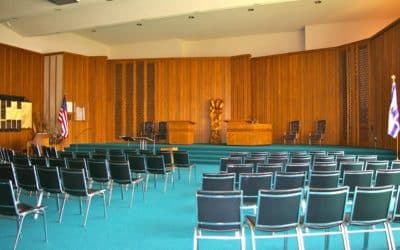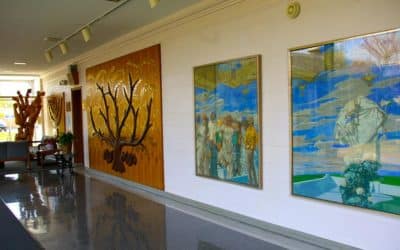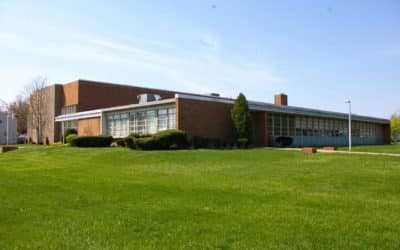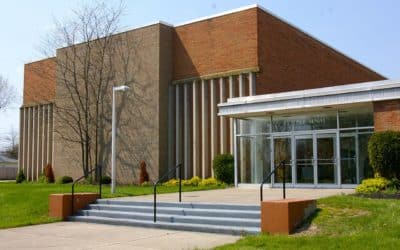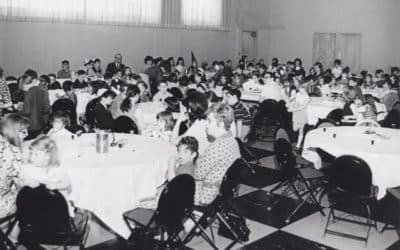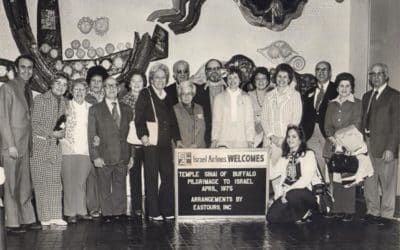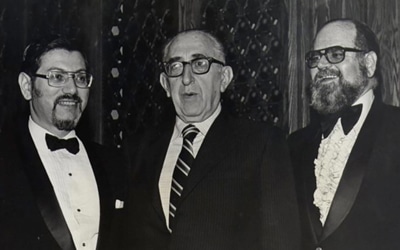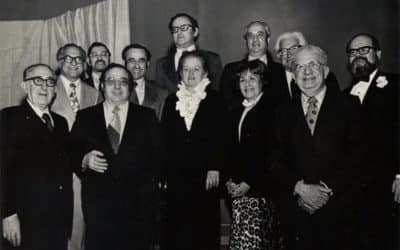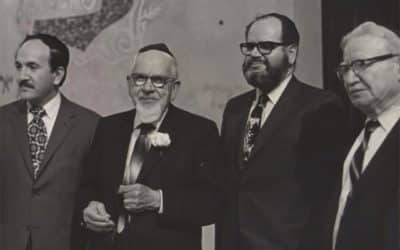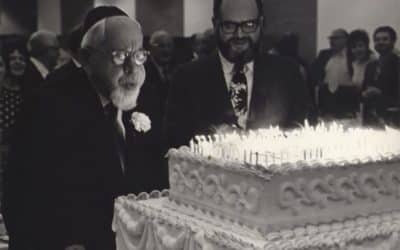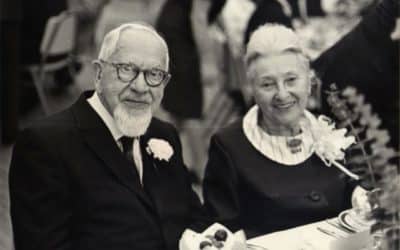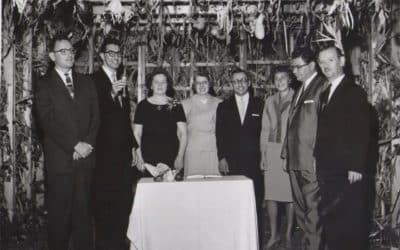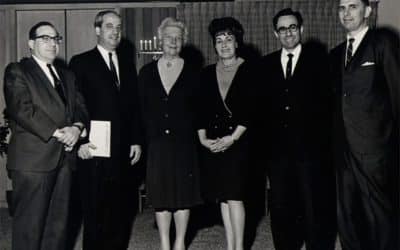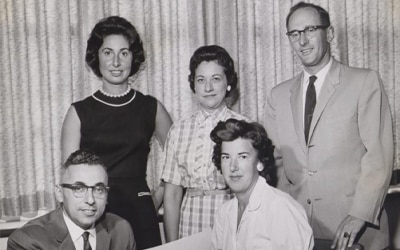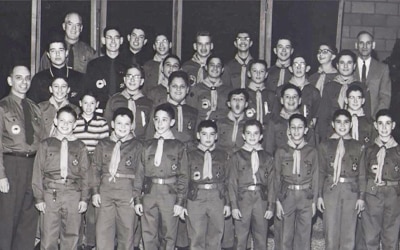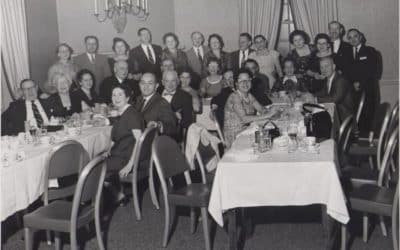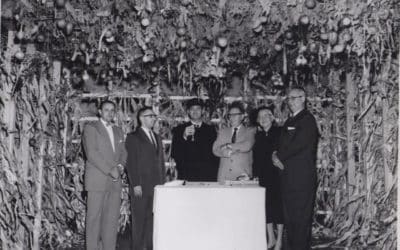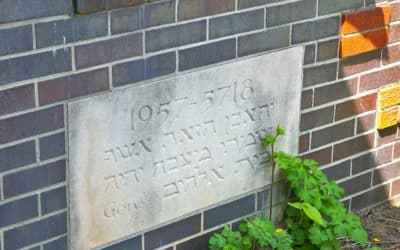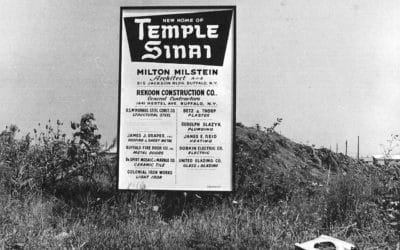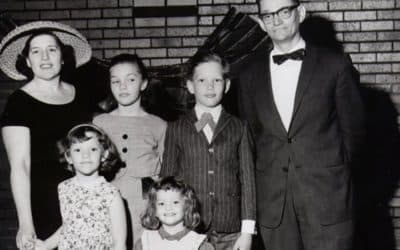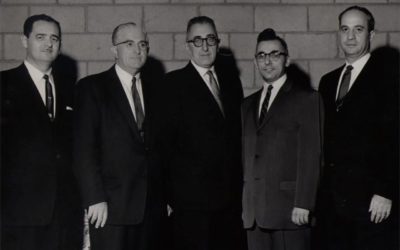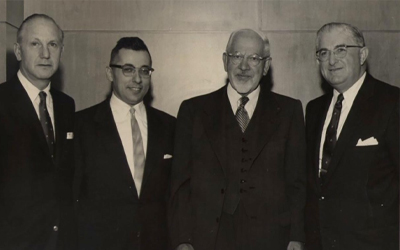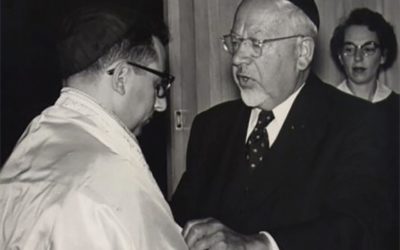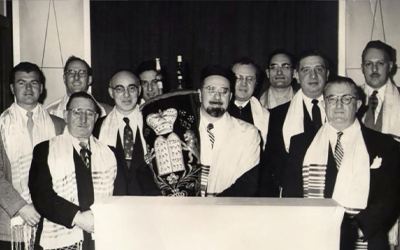Synagogues / Temple Sinai
Founded in 1952 in Amherst, NY, Temple Sinai was the first suburban and the first Reconstructionist synagogue in Greater Buffalo. In 2012 it merged with Temple Beth Am to form the world’s first jointly constituted Reconstructionist-Reform congregation named Congregation Shir Shalom.
Overview
At a meeting organized by Louis Bunis on August 24, 1952, Temple Sinai came into being. Determining the need for a “new liberal conservative temple,” the assembled group agreed that this synagogue would provide a space for “relevant, dynamic, positive and creative Judaism.” The nascent congregation became the first congregation in the suburbs, and the first and Reconstructionist congregation in the Greater Buffalo area. Twenty-eight men and women from the families of Borins, Bunis, Estry, Feld, Frey, Goldman, Goldstein, Gross, Kaufman, Posner, Rekoon, Shapiro, Snitzer and Wunder signed the articles of incorporation. On October 24, 1952, the newly formed congregation held their first service within the home of the Lyndale Evangelical and Reformed Church. Rabbi Harold Weisburg, Cantor Harry Kaufman (formerly of Temple Beth El), and organist Ruth Axelrod served as service leaders. The building was formally dedicated on April 26, 1953 with guest speaker, (Rabbi) Dr. Ira Eisenstein, editor of The Reconstructionist. A year later, on April 1, 1954, Rabbi Nathan Gaynor, the congregation’s first rabbi was installed by Dr. Mordecai Kaplan, a founder of the Reconstructionist Movement.
Growing rapidly, the congregation made plans for its own purpose-built synagogue and selected a tract of land on Alberta Drive in Amherst. In 1955, the congregation held a groundbreaking ceremony and a year later hosted the first national conference of the Reconstructionist movement. The cornerstone laying for the new synagogue took place on Sunday, November 3, 1957 and the first service at the site was held on August 22, 1957. The building was designed by Milton Milstein, architect of the Jewish Community Center and the Rosa Coplon Jewish Old Folks Home. His design with a tan brick exterior, complemented the buildings of the suburb residential neighborhood, even as its plot consumed more than 10 housing lots on the corner of Alberta Drive and Delta Road. The square shaped building had a rising sanctuary space and a low single-story entrance. The wrap around office and classroom space encased an interior courtyard. As an example of mid-century modern ecclesiastic architecture, it is a key structure in a pending historic district application.
The early and mid 1950s had been a flurry of firsts for Temple Sinai and the 1960s proved equally energizing. In 1965, Temple Sinai celebrated its Bar Mitzvah year, with a first joint adult bar and bat mitzvah ceremony. Temple Sinai weathered the departure of Rabbi Gaynor, who left to become director of Hillel at University of Illinois. Rabbi Paul Levenson served as an interim rabbi with the congregation from 1966 to 1968. At the end of the 1960s, Rabbi Joseph D. Herzog, began a 25-year rabbinate with Temple Sinai emerging as a significant force in progressive Judaism locally and nationally until his retirement in the 1990s.
Following Rabbi Herzog’s retirement, a number of rabbis served the congregation. Rabbi Barry Schwartz joined in 1993, and during his tenure began the Jubilee Endowment Fund as well as editing a new Shabbat prayer book. Rabbi Benjamin (Jamie) Arnold, took over in 1999. The first Reconstructionist trained rabbi to serve at Temple Sinai, and originally from Western New York, he served the Temple for five years until relocating to Denver, Colorado in 2005. Rabbi Jerry Seidler served for the next three years, when he left for the position of the Jewish Staff Chaplain at Sinai and Northwest Hospitals in Baltimore, MD. At this time the synagogue, like many others in the region, had a contracting membership base, and it’s classrooms were underutilized. Appointed in 2008, Rabbi Alex Lazarus-Klein was the Temple’s third Reconstructionist trained rabbi. During his rabbinate, the congregation made the decision to merge. As the sole Reconstructionist synagogue in Buffalo, a merger with another stream of Judaism would create a unique partnership. After discussion talks beginning in 2010, the Reform suburban synagogue, Temple Beth Am merged with Temple Sinai. In the newly named Congregation Shir Shalom, they became the first joint Reconstructionist-Reform temple in the United States.
Locations
Architectural Information
Articles
Buffalo-area synagogues merge
Buffalo-area synagogues merge, Jewish Telegraphic Agency, April 25, 2012
2 Jewish congregations weigh merger Beth Am, Sinai facing dwindling memberships
2 Jewish congregations weigh merger Beth Am, Sinai facing dwindling memberships, Buffalo News, Feb 22, 2012
Two temples merging into Congregation Shir Shalom
Congregation Shir Shalom Merger: “Two temples merging into Congregation Shir Shalom,” Buffalo News, Apr 25, 2012
Documents
Gallery
Temple Sinai, Courtyard Artwork, Created by Marty Wolpin, 2012. Courtesy of Congregation Shir Shalom.
Temple Sinai, Courtyard Artwork
Temple Sinai, Interior, Sanctuary, Created by Marty Wolpin, 2012. Courtesy of Congregation Shir Shalom.
Temple Sinai, Interior, Sanctuary
Temple Sinai, Sanctuary Tree of Life Donor Wall, Created by Marty Wolpin, 2012. Courtesy of Congregation Shir Shalom.
Temple Sinai, Sanctuary Tree of Life Donor Wall
Temple Sinai, Interior, hallway art work, Created by Marty Wolpin, 2012. Courtesy of Congregation Shir Shalom.
Temple Sinai, Interior, Hallway Art Work
Temple Sinai, Entrance way, Exterior, Building, Created by Marty Wolpin, 2012. Courtesy of Congregation Shir Shalom.
Temple Sinai, Entrance Way, Exterior
Temple Sinai, School Classrooms, Exterior, Building, Created by Marty Wolpin, 2012. Courtesy of Congregation Shir Shalom.
Temple Sinai, School Classrooms, Exterior
Temple Sinai, Sanctuary Exterior, designed by Milton Milstein, Photograph Created by Marty Wolpin, 2012. Courtesy of Congregation Shir Shalom.
Temple Sinai, Sanctuary Exterior
Temple Sinai, Congregational Religious Seder, 1960s. Courtesy of Congregation Shir Shalom.
Temple Sinai, Congregational Religious Seder, 1960s
Temple Sinai, Congregational pilgrimage to Israel, April 1975. Courtesy of Congregation Shir Shalom.
Temple Sinai, Congregational pilgrimage to Israel
Temple Sinai, L-R : Temple President, Elliott Shapiro, Rabbi Ira Eisenstein and Rabbi Joseph Herzog, 14th Annual Convention of the Reconstructionist Federation of Congregation and Fellowships, May 4, 1974. Courtesy of Congregation Shir Shalom.
Temple Sinai, 14th Annual Convention of the Reconstructionist Federation of Congregation and Fellowships
Temple Sinai, Past Presidents, Twentieth Anniversary Dinner, with Rabbi Ira Eisenstein (L) and Rabbi Joseph Herzog (R), 1973. Courtesy of Congregation Shir Shalom.
Temple Sinai, Past Presidents, Twentieth Anniversary Dinner
Temple Sinai, Rabbi Mordecai Kaplan 90th Birthday at Temple Beth Zion, L-R : Rabbi Herman Horowitz, Rabbi Mordecai Kaplan, Rabbi Joseph Herzog, and Rabbi Isaac Klein, 1971. Courtesy of Congregation Shir Shalom.
Temple Sinai, Rabbi Mordecai Kaplan 90th Birthday at Temple Beth Zion
Temple Sinai, Rabbi Mordecai Kaplan 90th Birthday, Rabbi Mordecai Kaplan (R), and Rabbi Herzog (L), 1971, Courtesy of Congregation Shir Shalom.
Temple Sinai, Rabbi Mordecai Kaplan 90th Birthday Candles
Temple Sinai, Rabbi Mordecai Kaplan 90th Birthday, L-R : Rabbi Mordecai Kaplan and Rivka Rieger Kaplan, Buffalo, 1971. Courtesy of Congregation Shir Shalom.
Temple Sinai, Rabbi Mordecai Kaplan 90th Birthday
Celebrating Sukkot in the Sukkah, 1960s, Courtesy of Congregation Shir Shalom.
Temple Sinai, Celebrating Sukkot in the Sukkah, 1960s
L-R: David Busch, Cantor Alan Edwards, Ruth Goldman, Muriel House, Rabbi Gaynor, Edith Goldstein, Shale Freidman and Morris Sobel, 1960s.
Confirmation Class, Rabbi Paul Levenson, 1968. Courtesy of Congregation Shir Shalom.
Temple Sinai, Confirmation Class, Rabbi Paul Levenson, 1968
Temple Sinai, Bar Mitzvah Year, 1965. Courtesy of Congregation Shir Shalom.
Temple Sinai, Bar Mitzvah Year, 1965
L-R: Leonard Goodman, Harold Axelrod, Center: Judith Kaplan Eisenstein, Edith Goldstein, Martin Wolpin, and Leon Siegel.
Temple Sinai, Bar Mitzvah Year Celebration, 1965. Courtesy of Congregation Shir Shalom.
Temple Sinai, Bar Mitzvah Year Celebration, 1965
Temple Sinai, Lay Leaders with Rabbi Gaynor, 1960s. Courtesy of Congregation Shir Shalom.
Temple Sinai, Lay Leaders with Rabbi Gaynor, 1960s
Temple Sinai, Religious School, 1960s. Courtesy of Congregation Shir Shalom.
Temple Sinai, Religious School, 1960s
Temple Sinai, Boy Scout troop, 1960s. Courtesy of Congregation Shir Shalom
Temple Sinai, Boy Scout troop, 1960s
Nate Finkelstein, standing on left (with a badge on his arm) was a troop leader during the 1960s
Temple Sinai, Credit Union Dinner, 1960s, Courtesy of Congregation Shir Shalom.
Temple Sinai, Credit Union Dinner, 1960s
Temple Sinai, Celebrating Sukkot in the 1960s. Courtesy of Congregation Shir Shalom.
Temple Sinai, Celebrating Sukkot in the 1960s
Temple Sinai, Cornerstone, From Genesis 28:22, “And this stone, which I have placed as a monument, shall be a house of God.” 1957. Courtesy of Congregation Shir Shalom.
Temple Sinai, Cornerstone
Temple Sinai, Synagogue Building Site, Milton Milstein, Architect, 1957, Courtesy of Congregation Shir Shalom.
Temple Sinai, Synagogue Building Site, 1957
Temple Sinai, Members, Ruth and Joseph Bolinsky (artist) with his family, 1950s, Courtesy of Congregation Shir Shalom.
Temple Sinai, Members, Ruth and Joseph Bolinsky and Family
Temple Sinai, 1954. Courtesy of Congregation Shir Shalom.
Temple Sinai, 1954
L-R, Cantor Sternberg, Louis Bunis, Rabbi Ira Eisenstein, Rabbi Nathan Gaynor and Harold Axelrod.
Temple Sinai, Religious School, 1950s. Courtesy of Congregation Shir Shalom.
Temple Sinai, Religious School, 1950s
Temple Sinai, Installation of Rabbi Nathan Gaynor, 1954. Courtesy of Congregation Shir Shalom.
Temple Sinai, Installation of Rabbi Nathan Gaynor, 1954
L-R: Lester Gross, Rabbi Nathan Gaynor, Rabbi Mordecai Kaplan, and Louis Bunis, 1954.
Temple Sinai, Installation of Rabbi Nathan Gaynor (L) by Rabbi Mordecai Kaplan (R), 1954. Courtesy of Congregation Shir Shalom.
Temple Sinai, Installation of Rabbi Nathan Gaynor (L) by Rabbi Mordecai Kaplan (R), 1954
Temple Sinai, First Shabbat Kiddush, 1953. Courtesy of Congregation Shir Shalom.
Temple Sinai, First Shabbat Kiddush, 1953
Temple Sinai, Lyndale Avenue synagogue, 1952. Courtesy of Congregation Shir Shalom.
Temple Sinai, Lyndale Avenue Synagogue, 1952
Discover More
- Newspaper ArticlesBuffalo Courier Express, March 4, 1954.Buffalo Courier Express, August 29, 1954.Buffalo Courier-Express, Sept. 19, 1954.
- Rabbi Nathan Gaynor: The Lantern, 21 August 1969
- Rabbi Joseph Herzog: Rabbi Joseph Herzog Challenges Segregation
University Archives, University at Buffalo, NY Small amounts of Temple Shaarey Zedek Materials are located in three collections:
The papers of Charlotte E. Gendler, Muriel Selling and the Jewish Genealogical Society of Greater Buffalo. To explore their collection summaries, please select a link.
Thank You
Our thanks to Congregation Shir Shalom for sharing materials from their digital archives.




